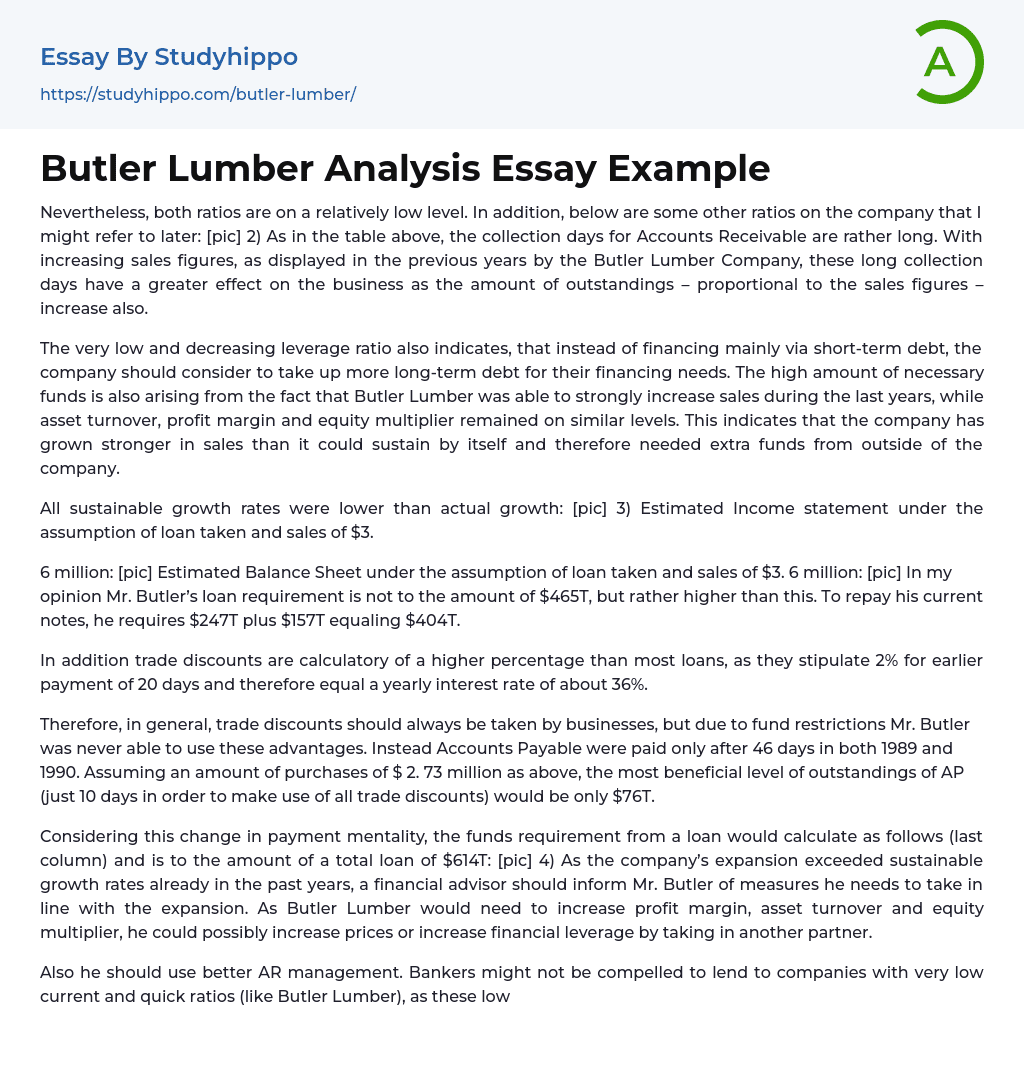Nevertheless, both ratios are on a relatively low level. In addition, below are some other ratios on the company that I might refer to later: [pic] 2) As in the table above, the collection days for Accounts Receivable are rather long. With increasing sales figures, as displayed in the previous years by the Butler Lumber Company, these long collection days have a greater effect on the business as the amount of outstandings – proportional to the sales figures – increase also.
The very low and decreasing leverage ratio also indicates, that instead of financing mainly via short-term debt, the company should consider to take up more long-term debt for their financing needs. The high amount of necessary funds is also arising from the fact that Butler Lumber was able to strongly increase sales during the last years
..., while asset turnover, profit margin and equity multiplier remained on similar levels. This indicates that the company has grown stronger in sales than it could sustain by itself and therefore needed extra funds from outside of the company.
All sustainable growth rates were lower than actual growth: [pic] 3) Estimated Income statement under the assumption of loan taken and sales of $3.
6 million: [pic] Estimated Balance Sheet under the assumption of loan taken and sales of $3. 6 million: [pic] In my opinion Mr. Butler’s loan requirement is not to the amount of $465T, but rather higher than this. To repay his current notes, he requires $247T plus $157T equaling $404T.
In addition trade discounts are calculatory of a higher percentage than most loans, as they stipulate 2% for earlier payment of 20 days and therefor
equal a yearly interest rate of about 36%.
Therefore, in general, trade discounts should always be taken by businesses, but due to fund restrictions Mr. Butler was never able to use these advantages. Instead Accounts Payable were paid only after 46 days in both 1989 and 1990. Assuming an amount of purchases of $ 2. 73 million as above, the most beneficial level of outstandings of AP (just 10 days in order to make use of all trade discounts) would be only $76T.
Considering this change in payment mentality, the funds requirement from a loan would calculate as follows (last column) and is to the amount of a total loan of $614T: [pic] 4) As the company’s expansion exceeded sustainable growth rates already in the past years, a financial advisor should inform Mr. Butler of measures he needs to take in line with the expansion. As Butler Lumber would need to increase profit margin, asset turnover and equity multiplier, he could possibly increase prices or increase financial leverage by taking in another partner.
Also he should use better AR management. Bankers might not be compelled to lend to companies with very low current and quick ratios (like Butler Lumber), as these low ratios do not indicate a good ability to repay loans.
Apart from the conditions already mentioned in the case, Northrop National Bank will also have an interest in limited growth of Butler Lumber, so they might also suggest some of the measure above in order to raise the sustainable growth rate.
- Commercial Bank essays
- Debit Card essays
- Deposit Account essays
- Subprime Lending essays
- Payment essays
- Rate Of Return essays
- Funding essays
- Hedge Fund essays
- Accountability essays
- Accounting Software essays
- Accounts Receivable essays
- Auditor's Report essays
- Balance Sheet essays
- Cash essays
- Cash Flow essays
- Costs essays
- Financial Audit essays
- Internal Control essays
- International Financial Reporting Standards essays
- Management Accounting essays
- Principal essays
- Tax essays
- Bank essays
- Banking essays
- Corporate Finance essays
- Credit Card essays
- Currency essays
- Debt essays
- Donation essays
- Enron Scandal essays
- Equity essays
- Financial Accounting essays
- Financial Crisis essays
- Financial News essays
- Financial Ratios essays
- Financial Services essays
- Forecasting essays
- Foreign Exchange Market essays
- Free Market essays
- Gold essays
- Investment essays
- Legacy essays
- Loan essays
- Market Segmentation essays
- Money essays
- Personal finance essays
- Purchasing essays
- Retirement essays
- Shareholder essays
- Stock Market essays




